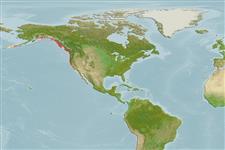Common names from other countries
Environment: milieu / climate zone / depth range / distribution range
Ecologia
marinhas demersal; intervalo de profundidade 20 - 80 m (Ref. 51666). Temperate
Eastern Pacific: Aleutian Islands, Alaska to San Miguel Island, southern California, USA.
Tamanho / Peso / Idade
Maturity: Lm ? range ? - ? cm
Max length : 15.0 cm TL macho/indeterminado; (Ref. 2850)
Descrição breve
Chaves de identificação | Morfologia | Morfometria
Espinhos dorsais (total) : 53 - 55; Raios dorsais moles (total) : 0; Espinhos anais: 1; Raios anais moles: 37 - 42. Caudal rounded (Ref. 6885). Color variable- males brownish, sometimes with a red tinge; pale spots rimmed with darker on sides of body; spots fainter, smaller, and more numerous dorsally on sides; light on lower part of head with several brown streaks; white on pelvic fins and anterior part of anal fin; other fins with brown pigment spots in bands forming faint bars. Females nearly plain brown on body; in line spread along middle of dorsal fin about 13 dark spots each surrounded by a clear area to form prominent ocelli (Ref. 6885).
Usually in intertidal and subtidal rocky areas (Ref. 2850, 51666). Sometimes hides in crevices and tubeworms holes with only head protruding (Ref. 2850).
Life cycle and mating behavior
Maturities | Reprodução | Spawnings | Egg(s) | Fecundities | Larvas
Eschmeyer, W.N., E.S. Herald and H. Hammann, 1983. A field guide to Pacific coast fishes of North America. Boston (MA, USA): Houghton Mifflin Company. xii+336 p. (Ref. 2850)
Categoria na Lista Vermelha da IUCN (Ref. 130435)
CITES (Ref. 128078)
Not Evaluated
Ameaça para o homem
Harmless
Utilização humana
Pescarias: espécies comerciais; Aquário: Espécies comerciais
Ferramentas
Relatórios especiais
Descarregue XML
Fontes da internet
Estimates based on models
Preferred temperature (Ref.
115969): 4.9 - 11.6, mean 7.9 (based on 39 cells).
Phylogenetic diversity index (Ref.
82804): PD
50 = 0.5039 [Uniqueness, from 0.5 = low to 2.0 = high].
Bayesian length-weight: a=0.00372 (0.00147 - 0.00941), b=3.17 (2.95 - 3.39), in cm Total Length, based on LWR estimates for this (Sub)family-body shape (Ref.
93245).
Nível Trófico (Ref.
69278): 3.6 ±0.50 se; based on food items.
Resiliência (Ref.
120179): Médio, tempo mínimo de duplicação da população 1,4 - 4,4 anos (Preliminary K or Fecundity.).
Fishing Vulnerability (Ref.
59153): Low vulnerability (10 of 100).
